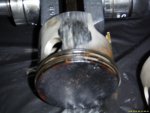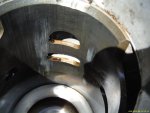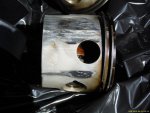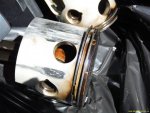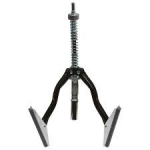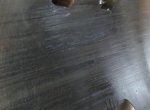"Rod Knock" Turns out to be top cylinder piston slap - what caused and how to fix it?
Hi All,
My posts started out with questions about a knocking noise - see previous posts for background if interested.
Anyway, I pulled the crankshaft and pistons out (1991 75hp 2-stroke) and the top piston is scored in multiple places see pictures below:

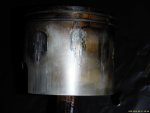
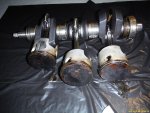

The abbreviated version of the background is the fuel pump check valves failed so I'm assuming the engine was running lean. Knock is worst at idle. No knock immediately after running under load at 2500rpm back to idle in neutral. Probably was a lot of carbon build up - did a concentrated SeaFoam treatment before I removed the power head. Compression when warm 110 - 105 -110 - (T, M, B) questionable HF tester.
I measured the cylinder bore as close to in parallel and perpendicular to the wrist pin at the top and bottom of the cylinders and I don't have my notes with me right now but they measure good, in fact a little under 3.375. OOR is less than 0.001, same for taper. I think the average bore diameter was around 3.3720. Even the top scored cylinder measurement on the worst scored section was 3.3735 as I recall but the gauge would have measured the peaks...
The two bottom pistons and cylinders show no sign of contact. Nice cross hatch pattern on the cylinder walls. The top piston was contacting the cylinder walls in a number of places all around. The last picture is the worst area that extends the entire length of the piston. On the other side there are smaller spots that do not extend the whole length.
When I pulled the pistons out, the top ring on the bad cylinder was not totally free. All I had to do was rotate it a little to free it up.
I haven't taken the rod off yet so I don't have the journal, rod, and pin measurements yet but there isn't noticeable play at either the crankshaft or the wrist pin. The top piston linkage feels exactly the same as the other two to me. The rod is discolored more than the others near the piston (brown) for about 1.5" below the wrist pin. It is not noticeably warped.
So, my question is what should I be looking for? What additional measurements should I make?
I want to make sure that I understand what happened and replace what needs to be replaced, but not what does not need to be replaced. Assuming the rod, journal, wrist pin, and bearings measure good and I replace the rings and either re-hone or bore to the next oversize piston it seems to me that it will just happen again.
I'm thinking that the discoloration of the rod probably means the engine overheated but not because of lack of water circulation and the sensor did not get hot enough to trigger. Now with the cylinder walls scored, I suppose the rings get hung up a little and that makes the piston tilt? Was the top ring really stuck due to carbon buildup that I mostly cleared with the SeaFoam but by then the damage was done?
Anyway, if you have any suggestions, please post. I guess I will be taking it to a machine shop and those guys will double check my measurements.
Thanks in advance,
Greg
Hi All,
My posts started out with questions about a knocking noise - see previous posts for background if interested.
Anyway, I pulled the crankshaft and pistons out (1991 75hp 2-stroke) and the top piston is scored in multiple places see pictures below:




The abbreviated version of the background is the fuel pump check valves failed so I'm assuming the engine was running lean. Knock is worst at idle. No knock immediately after running under load at 2500rpm back to idle in neutral. Probably was a lot of carbon build up - did a concentrated SeaFoam treatment before I removed the power head. Compression when warm 110 - 105 -110 - (T, M, B) questionable HF tester.
I measured the cylinder bore as close to in parallel and perpendicular to the wrist pin at the top and bottom of the cylinders and I don't have my notes with me right now but they measure good, in fact a little under 3.375. OOR is less than 0.001, same for taper. I think the average bore diameter was around 3.3720. Even the top scored cylinder measurement on the worst scored section was 3.3735 as I recall but the gauge would have measured the peaks...
The two bottom pistons and cylinders show no sign of contact. Nice cross hatch pattern on the cylinder walls. The top piston was contacting the cylinder walls in a number of places all around. The last picture is the worst area that extends the entire length of the piston. On the other side there are smaller spots that do not extend the whole length.
When I pulled the pistons out, the top ring on the bad cylinder was not totally free. All I had to do was rotate it a little to free it up.
I haven't taken the rod off yet so I don't have the journal, rod, and pin measurements yet but there isn't noticeable play at either the crankshaft or the wrist pin. The top piston linkage feels exactly the same as the other two to me. The rod is discolored more than the others near the piston (brown) for about 1.5" below the wrist pin. It is not noticeably warped.
So, my question is what should I be looking for? What additional measurements should I make?
I want to make sure that I understand what happened and replace what needs to be replaced, but not what does not need to be replaced. Assuming the rod, journal, wrist pin, and bearings measure good and I replace the rings and either re-hone or bore to the next oversize piston it seems to me that it will just happen again.
I'm thinking that the discoloration of the rod probably means the engine overheated but not because of lack of water circulation and the sensor did not get hot enough to trigger. Now with the cylinder walls scored, I suppose the rings get hung up a little and that makes the piston tilt? Was the top ring really stuck due to carbon buildup that I mostly cleared with the SeaFoam but by then the damage was done?
Anyway, if you have any suggestions, please post. I guess I will be taking it to a machine shop and those guys will double check my measurements.
Thanks in advance,
Greg




















